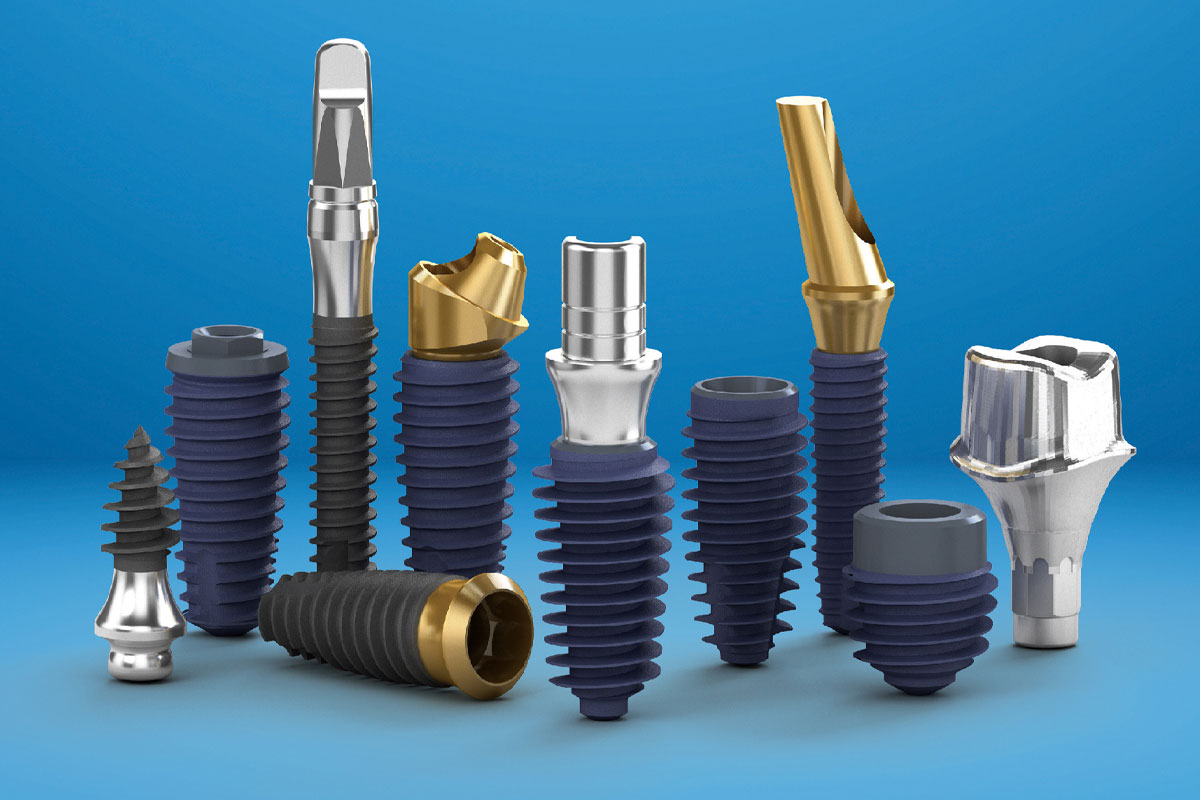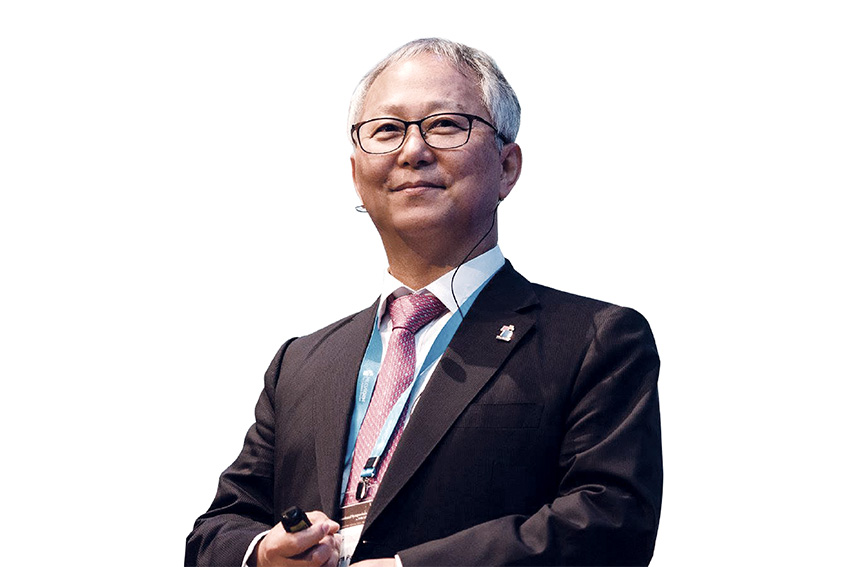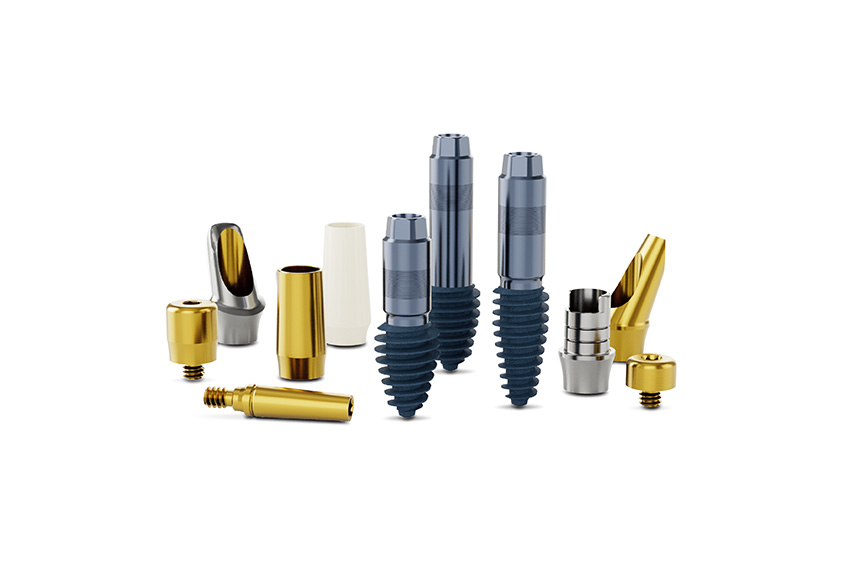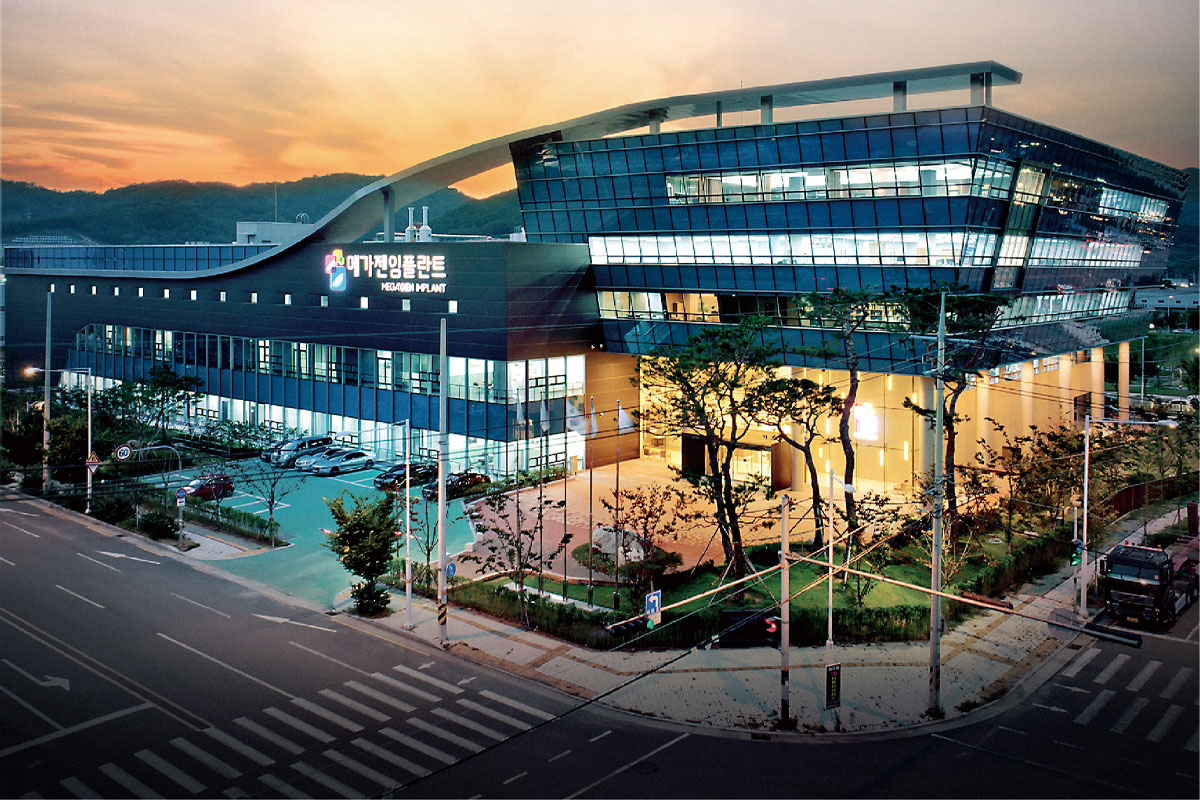AnyRidge, the world-famous blue implant from MegaGen, has welcomed a new addition to the family: ARi ExCon. This implant is specifically designed for anterior atrophic ridges, incorporating 20 years of effective results to accelerate recovery and simplify ridge surgery.

Korea's growth in the medical and the dental production devices field is a noteworthy phenomenon with a CAGR of 22% between 2017 and 2022. What is particularly intriguing is that this growth has occurred despite the generally conservative nature of dentists and medical institutions. What do you believe are the key drivers to surmount this barrier? To what extent can we attribute this challenge to a matter of reputation versus a matter of technology?
The efforts we've made to overcome such challenges may seem innovative, but the amount of effort and time invested is comparable to that of our Japanese or German counterparts. I believe innovation could swiftly emerge from Korea, primarily because the drivers were the dentists and clinicians encountering these challenges firsthand, allowing them to address issues that European or US market providers couldn't. In the early 1990s, the clinician community in Korea received support from implant providers in the US and European markets for education and training. However, it didn't fully align with the Korean landscape. We proposed modifications to these implant providers, suggesting adjustments that would better suit the Korean context. Unfortunately, these changes weren't implemented because the implant providers perceived Korea as a small market, insisting on adherence to their established practices. Dissatisfaction in Korea began to simmer, prompting us to recognize the importance of cultivating an implant community tailored to the Korean landscape.
One distinguishing factor that set us apart from competitors was our dedicated education group, operating under the philosophy that our implant performance and quality must be recognized by the US or EU markets, rather than focusing solely on sales and marketing activities in Northeast Asia or China, which are relatively easier targets. We believed that our brand reputation needed validation from the US or European markets to amplify our voice.
Your strategy was to gain brand recognition from the US and Europe as a seal of quality rather than seeking approval from the Asian market. You began your internationalization journey very early, which took much longer to expand internationally. In your opinion, what are the biggest challenges for Korean dentistry companies when it comes to going global?
When we first embarked on this journey, we didn't define it as an international strategy. It was simply our enthusiasm to showcase our tier-one biological concept and quality to the world. As clinicians ourselves, this was a source of pride for us, driven by our dedication to excellence rather than merely entrepreneurial ambitions. Recognizing that the European and US markets have been at the forefront of the implant industry for over five decades, we understood the importance of building our brand reputation to be on par with industry leaders like those in the US and the EU. Merely competing on cost-effectiveness wouldn't suffice in the long term. We realized that focusing solely on immediate revenue gains would be shortsighted. In an increasingly interconnected global community, the importance of evidence-based practices and validation from the global community became evident. Therefore, we chose to take gradual steps rather than pursue short-term gains.
Today, it's concerning to see that many pieces of evidence featured in articles or even in world-renowned journals turn out to be biased or skewed toward specific companies. These instances undermine the integrity of evidence-based practices and can mislead practitioners and consumers alike.
You mentioned that the US and EU have been spearheading the industry, particularly in terms of market share. However, I'm curious if they still lead in innovation and trends. Korea is recognized as one of the most innovative markets globally, and we've seen the introduction of trends such as same-day treatment and minimally invasive procedures. What are your opinions on these new trends in the dentistry sector in Korea, and how do they compare to global trends?
Minimally invasive and same-day treatments are generating significant buzz in the global dental community. I believe the US and European markets have their constraints, as they approach any modification with no big caution which leads to potential errors and subsequent lawsuits. Such setbacks can dampen enthusiasm in these markets. Conversely, Korean medical practitioners, known for their talent and skill, have more flexibility to take on challenges. Unlike fields where lives are at stake, dentistry allows for more experimentation and adjustment. We're not bound by rigid adherence to traditional techniques. Instead, we embrace trial and error, meticulously gathering data to refine our approaches and improve patient outcomes.
The development of minimally invasive and same-day treatments is not an overnight occurrence. Unlike industries like pharmaceuticals or IT, where major innovations often stem from theoretical breakthroughs, dentistry relies on close observation of even the smallest changes, coupled with direct engagement with patients. We continuously accumulate data to drive innovation. While adhering to the fundamental principles established by legacy companies like Straumann or Nobel Biocare in the European market, Korean medical practitioners are quick to embrace new techniques and technologies that offer convenience and efficiency. We prioritize nimble adaptation to ensure our patients receive the best possible care.
For clinics and dentists, implementing modern procedures requires understanding these practices and receiving direct feedback from the specialized community. The industry has witnessed the proliferation of networks gathering clinicians worldwide, webinars, and courses. Could you elaborate on how communication between practitioners, academia, and the private sector facilitates the global implementation of new procedures?
In our early stages, our success surpassed that of our competitors because we didn't solely focus on marketing or promotions. Since around 2009 or 2010, I personally lectured on our product and AnyRidge. Initially, comprehension of AnyRidge was limited among attendees for the next two to three years. However, some physicians who attended the lectures recognized the validity of our concept in theory. They experimented with it themselves and returned with positive feedback, acknowledging the superiority of our concept compared to legacy companies like Straumann. These physicians played a crucial role in marketing and promotion through word of mouth, recommending our product to other physician communities. Their impartiality, as non-entrepreneurs, particularly resonated with European market physicians.
As a small company, we initiated the symposium to elevate our visibility to the broader audience. We believed that a well-organized symposium could attract more stakeholders, amplifying our message. Regarding the Mega’mind competition, our aim was to nurture physicians and identify potential talented implant practitioners to cultivate the next generation of professionals. Participation in Megamind wasn't contingent on using a Megagen implant; rather, we sought individuals with a compassionate attitude toward their patients and a genuine enthusiasm for their work.
This year, we're targeting 500 participants globally, culminating in a final competition in Cannes where 21 candidates will compete. A panel of six judges will select the top six participants, who will then receive mentorship from industry experts for one week, focusing on improving their keynote speeches, presentation skills, and overall professional development. This platform provides participants with global exposure, accelerating their recognition within the industry in just a year or two. By nurturing passionate individuals and providing them with opportunities, we empower everyone to become industry leaders.

Park Kwang Bum, CEO of MegaGen Implant. Co., Ltd.
Could you define Megagen's role within the dentistry sector today? What key factors have contributed to your exponential growth over the last four years?
Initially, we didn't prioritize creating a cash cow product like our competitors did. Instead, we concentrated on R&D and identifying potential products, given my background as a medical practitioner. For instance, when I developed the Unit Chair, it was driven by my desire to address the drawbacks of existing unit chairs and enhance convenience for both patients and medical practitioners. I aimed to minimize patient and practitioner efforts while mitigating side effects associated with traditional unit chairs. Within just three years of development, N2 became a top-ranking product. This success stemmed from our focus on meeting the needs of medical practitioners and patients alike. By continuing this development trajectory, we anticipate creating gadgets that seamlessly integrate with the unit chair, tailored precisely to medical practitioners' needs and increasingly miniaturized for patient convenience.
We're also incorporating AI to facilitate more accurate and faster decision-making for medical practitioners, reducing errors. I oversee all R&D processes, with most ideas originating from me. Our ability to sustain R&D and drive improvement is rooted in my daily dedication to dental treatment as a medical practitioner. With nearly 40 years of experience in implant dentistry, I anticipate potential consequences and strive to anticipate the perspectives of both seasoned practitioners and newcomers. While I can execute treatments perfectly, it's essential for junior practitioners to achieve the same level of skill. This mindset shift is crucial for the development of new products and digital technologies aligned with industry needs.
Megagen has experienced remarkable growth over the last three to four years, achieving a notable 30% increase in sales in 2023 from the previous year, with expectations of further growth in the upcoming year. While AnyRidge appears to have played a significant role, could you provide more insight into the key factors shaping your business structure?
I believe our 30% growth was feasible due to our status as a relatively small-sized company. When considering our share of the overall global market, it remains relatively modest. Both medical practitioners and patients tend to prioritize established brands and reputation, which often favor legacy brands. However, there exists a niche market, comprising approximately 10 to 20%, that these legacy brands fail to fully serve. Our recently launched products specifically target this underserved segment, addressing challenges that are notoriously difficult to navigate. Through these specially designed offerings, we aim to capture this niche market. Our primary objective aligns with sustaining our annual growth rate of 30% until 2030. Even without introducing additional specialized products, our continued focus on training and education for medical practitioners should drive adoption of our niche products among patients seeking specialized care. I'm confident this strategy will enable us to maintain our growth trajectory.

ARi ExCon Implants
Another notable product is AnyRidge Incisor (ARi ExCon), designed specifically for front teeth implants. Prolonged denture use can lead to unique and delicate bone conditions in this area. Our innovative product, ARi, eliminates the need for bone grafts and offers simplified implementation, receiving enthusiastic feedback from the dental community. Last year alone, we successfully introduced ARi to 800 clinics. Additionally, we recently obtained approval for the US and Canadian markets, solidifying its position as our niche product. Meanwhile, our flagship products, Blue Diamond Implant and AnyRidge, are positioned to compete directly with legacy brands like Straumann, boasting competitive advantages and market readiness.
These superior-quality products effectively address difficult challenges. Could you walk us through the evolution from AnyRidge to the Blue Diamond Implant and how you are enhancing the Blue Diamond solution with R2GATE?
Both AnyRidge and Blue Diamond Implants are constructed from pure titanium, differing only in grade. Titanium grades range from one to four, with the fifth grade being an alloy boasting the highest strength. Historically, grade four titanium sufficed for dental implants. However, challenges arose, especially in prosthetics, where fractures occurred, and stability diminished. To overcome these issues, zirconia emerged as an alternative material due to its superior strength and aesthetic appeal, coupled with enhanced performance in CAD/CAM systems. Yet, technological advancements introduced new challenges for implants. Consequently, we set out to enhance the properties of grade four titanium.
Straumann initially introduced an alloy grade known as rock solid, which gained some traction among medical practitioners. However, the alloy exhibited weak bone adhesion. We sought to maintain the benefits of pure titanium while increasing strength to rival Straumann's offering. Thus, we redesigned a product with a structure and strength comparable to Straumann's.
Regarding R2GATE, it serves as a software platform integrated with our products. Development of this platform commenced in 2010, at a time when digital dentistry was not widely understood in Korea. Osstem was the first to introduce Denmark's 3-shape software, but we opted to develop our proprietary software engine. Initially, tier-one product demand wasn't significant, and adapting our software across various fields posed challenges. However, having our basic engine enabled us to make necessary modifications independently. This led to the development of FACEGIDE, facilitating R2GATE simulation to achieve precise outcomes desired by medical practitioners.
The trend of dental companies offering digital solutions for surgery, similar to Ray Medical's Ray Scanners for surgeons, is becoming more prevalent. In the long term, do you envision this as the future for dental companies like yours? Do you believe expanding offerings to include solutions not only for dentists but also for plastic surgeons represents the future of dental companies?
Absolutely. Currently, we are partnering with dental departments and oral surgeons, providing our products. After conducting two to three pilot tests, these departments and surgeons have realized that our solutions precisely align with their plans and desired outcomes, resulting in overwhelmingly positive feedback.
While our initial focus was on the dentistry market, we are now expanding our reach to include plastic surgeons as well. Plastic surgeons may have a lesser understanding of dental structure compared to dental practitioners, often seeking advice from dentists. However, with our R2GATE solution, they can streamline this process by reducing reliance on external consultations with dental professionals.
The fields of dental and medical surgery are interconnected, sharing the common goal of rectifying patient distortions. Leveraging our proprietary engine, we believe we can extend our applications beyond dentistry to other areas of the body, with our current focus being on facial procedures.

Headquarters
As a leading player in the international market, serving as the first exporter to Europe for many years and more recently to the U.S., how do you envision this growth and where do you see your market potential? What will drive Megagen's growth in the future, and will you continue to focus solely on Europe and the U.S., or do you anticipate expanding into other regions as a key factor for growth?
Given the current political and economic uncertainties, we recognize the importance of diversifying our market presence rather than concentrating all efforts in one region. For instance, while some competitors heavily rely on the Chinese market, we aim to maintain a balanced distribution across multiple regions. We are strategically targeting seven continents to ensure comprehensive global coverage. While the European market may yield the highest revenue currently, its growth potential is relatively lower compared to emerging regions such as the Middle East, Africa, and the CIS countries.
While the U.S. market sets trends and presents fierce competition, we understand the need to continuously monitor and adapt our strategies accordingly. However, while our focus remains on Europe and the U.S., we also acknowledge the significant potential of markets in the Middle East and North Africa. These regions hold considerable influence and impact in the global landscape.
While achieving a $1 billion revenue target may seem feasible, we remain mindful of unforeseen variables that may arise. Thus, we maintain a broad perspective, considering the overall global situation as we navigate our growth trajectory.
As both a practitioner and a CEO of an renown implant specialist, you are uniquely positioned to understand dentists and patients concerns. Could you share with us your vision of the future of dentistry?
I believe advancements in sophisticated AI and software can address uncertainties that patients might face, ultimately making patients more comfortable with their choice of procedure. This trajectory is where dentistry is headed. While expertise from medical practitioners with decades of experience was crucial in the past, AI and software can now address many challenges they once faced. Instead of solely focusing on equipment like CBCT or lasers, we prioritize addressing patient concerns. For us, we don't blindly follow trends.
Knowledge and perception are distinct. People may not recognize the value of innovations until they see the outcomes. Take AnyRidge, for example. Initially conceived in 2008, it wasn't widely recognized as an implant. Yet now, it contributes to around 90% of our export revenue. This discrepancy between knowledge and perception drives us to integrate various elements to produce results that resonate with our audience.
While our goal isn't solely to become a $1 billion company, envisioning a transformed dental environment by our target year is our primary objective.
For more details, explore their website at https://imegagen.com/
0 COMMENTS